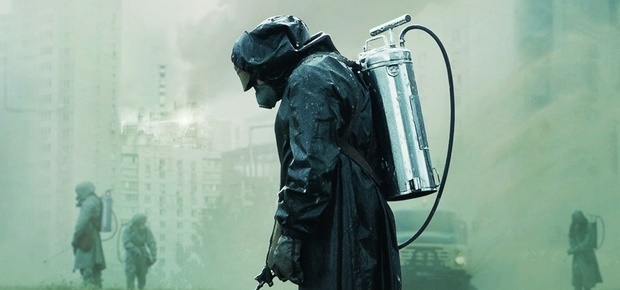
Early in the morning on 26 April 1986, technicians at the Vladimir Ilyich Lenin Nuclear Power Plant started a safety test on one of its reactors. But a combination of human error and design flaws caused an explosion that breached the reactor, sending huge amounts of deadly radiation into the surrounding areas.
These events are captured in the excellent HBO show Chernobyl, after the popular name for the nuclear power plant. To understand what happened and why, watch this lauded mini-series on Showmax as it walks through the accident, the conflicting interests and the unfolding of a major disaster at a breakneck pace.
But what about other nuclear power stations? In South Africa, we have one such site, Koeberg in the Western Cape. What are the chances that it will fail in the way Chernobyl had?There are three angles: the reactor, the people involved and the impact on the surrounding area. Let’s take a closer look at each.The reactor
Nuclear power reactors use heavy elements such as uranium to boil water into steam, which spins a turbine to generate electricity. Coal power stations work the same way, except a kilogram of uranium can generate more than a million times as much power as a kilogram of coal. To do this requires a careful balance inside what is essentially a giant, high-pressure and radioactive kettle. Get that balance wrong and things can go bad quickly.
Things went very wrong at Chernobyl, partly due to design flaws in its RBMK reactors. Koeberg, on the other hand, runs Pressurized Water Reactors (PWR). These don’t have the same flaw and are commonly used across the world, including the United States and numerous nuclear submarines. Of course, there could be unknown or unacknowledged flaws, but they are more likely to be spotted because PWR designs are widely used.
Safety is a key consideration with nuclear reactors, which is why they are so expensive. The mistakes made at sites such as Chernobyl are taken into consideration, explained Prof. Hartmut Winkler from UJ’s Department of Physics:
“The Koeberg reactors were built according to a later technology than that of, especially, Chernobyl, and their design includes additional safety mechanisms. For example, at Chernobyl, there was no 1-metre thick concrete encasement (a Koeberg feature), and so the explosion ripped the roof to shreds, and the highly contaminated, strongly radiating material escaped immediately.”
The people
Staff running a test at Chernobyl made terrible mistakes that pushed the reactor to its brink. Human error was involved in the majority of nuclear reactor failures. Are Koeberg’s people up to the task?
It’s actually difficult to drive a nuclear reactor to its edge. The mini-series on Showmax exposes how the ‘yes-sir’ culture of the USSR lead to problems. One benefit of a liberal democracy is that such negligence might be stopped sooner, because people are allowed to speak up. But how would Koeberg react during a problem?
In 2006, a loose bolt on one of the reactors led to blackouts in the area. Sabotage was suspected, but several investigations showed that it was a mistake. What should give comfort is that responses to the problem were relatively quick and thorough: Koeberg staff were even given lie-detector tests.
That being said, the incident was handled in a hushed fashion and Koeberg is still secretive about its procedures, as Prof. Winkler pointed out:
“I would not say that the Koeberg safety record compares too badly with other similar installations. Despite the increased difficulties faced by Eskom, I am not aware of evidence that safety standards have dropped at Koeberg in recent years. That, however, doesn't mean that things should not be improved. Eskom is unfortunately still stuck in the securocratic culture of the 1980s, and their communication is usually marked by terseness and lack of detail.”
So human error is still possible. But unlike Chernobyl, there are many third parties taking an interest in nuclear safety. In 2019 a blogger posted a video questioning safety at Koeberg. The site, as well as the National Nuclear Regulator, refuted the claims.The areaAfter Chernobyl happened, a 30-kilometre radius around it was evacuated. Today that radius is ten kilometres. Koeberg is less than 30 kilometres away from Cape Town. So if Koeberg went Chernobyl, would Cape Town need to be evacuated? And for how long?This depends on the accident itself. Nuclear reactors can’t explode. But the gas that builds up in them can - and did at Chernobyl. When the heated reactor met open air, fires started. The smoke carried radiation spread widely. The chances of Koeberg exploding in a similar fashion are very low. That being said, if Koeberg has an accident as bad as Chernobyl or Japan’s Fukushima (both rated 7 on the International Nuclear Event Scale), parts of Cape Town would likely have to be evacuated, if only temporarily.“The explosion would be far better contained than was the case in Chernobyl. What would rather happen (if a really bad accident were to ever happen!) is what occurred at Fukushima, where the problem was not so much an explosion. It would rather be the leaking and dispersion of highly radioactive material. The scale and danger associated with it would depend on the circumstances of the incident, which may lead to an evacuation.”But what about the radiation? The mini-series makes one major mistake: radiation isn’t contagious. It’s more like a poison: someone who has radiation sickness can’t give another person that radiation. But any surfaces that have radiation on them can - this is why people are scrubbed and washed if they come into contact with radiation. So the fallout won’t be as horrific as seen in the show, Chernobyl.It would still be bad, though. If Koeberg melted down, the immediate area would have to be isolated. If the resulting melted radioactive material (called Corium) gets into the groundwater, there may be serious problems. But nuclear reactors are built to contain themselves - some of the reactors at Fukushima have melted down, but are still contained.Can Koeberg go Chernobyl? Probably not and almost certainly not in the way that accident happened. But the show is a reminder that great power comes with great responsibility. Nuclear power is incredibly efficient and actually very safe. But become complacent and it will destroy swathes of land, empty towns and simmer for thousands of years. Chernobyl was a lesson: hopefully, the people running Koeberg have been listening.How to get ShowmaxIf you’re not a subscriber yet, you can sign up for a 14-day free trial and binge all of Chernobyl without paying a cent. Thereafter, access to a ton of local and international series, movies and documentaries costs just R99 per month. If you’re a DStv Premium subscriber, Showmax is included in your subscription - just go to the website to sign up. DStv Compact and Compact Plus subscribers can add Showmax to their subscription for just R49pm.




 Publications
Publications
 Partners
Partners















